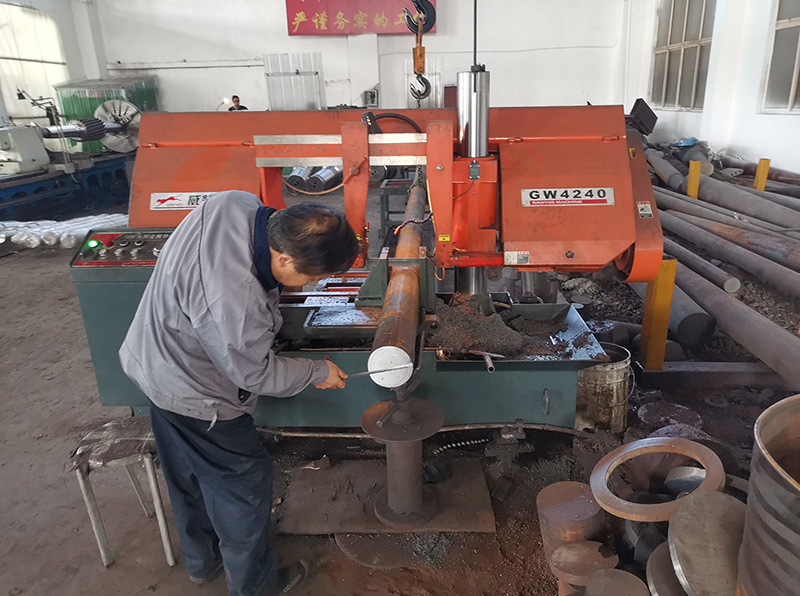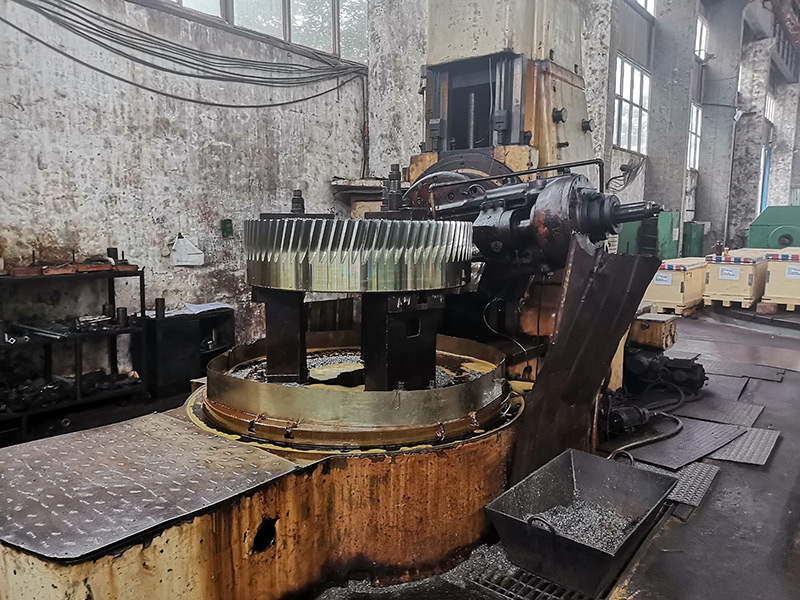

Forging equipment
Forging equipment is used to make formed products. Based on product shapes and quantities, forging can be done using free forging equipment, mold forging equipment, ring rolling equipment, and other equipment. Free forging equipment is mostly used for products involving small quantities, various shapes, and large volumes; mold forging equipment is mostly used for products that are produced in batches, have a single shape, and are small to medium-sized; ring rolling equipment, as the name suggests, is a hollow circular piece.

Heat Treatment Equipment
Heat treatment equipment includes pre-production heating equipment, normal post-production tempering equipment, quenching and tempering equipment, vacuum carburizing equipment, vacuum nitriding equipment, surface quenching equipment, etc., used to produce different products based on their technical requirements.

Sawing Machine
Sawing machines are used for producing cuttings, mostly in the pre-production blanking process and for post-production excess part cutting.

Horizontal Lathe
Horizontal lathes have similar characteristics as general lathes, and can be used to turn internal and external circles, conical surfaces, end faces, boring, grooving, drilling, knurling, and can also be used to turn commonly used metric and inch threads.

Floor-type Boring and Milling Machine
The floor-type boring and milling machine is a heavy-duty boring machine that fixes large workpieces on a floor platform for boring and milling. It integrates functions of boring and milling machines, which increases processing efficiency and precision, greatly improving product quality and labor efficiency.

Drilling Machine
Drilling machines mainly use drills to process holes on workpieces. Generally, the main movement is the drill head rotation, and the end movement is the drill head feeding. The drilling machine has a simple structure, however, the processing accuracy is relatively low. The machine can drill through holes and blind holes, replace special tools, expand holes, perform spot facing, ream, or tap holes. During the drilling process, the workpiece must be immobilized, and the tool is then moved to align the cutter center with the hole center, before turning the cutter (main movement).

Grinding Machine
Grinding machines are machine tools that use milling gear to grind the workpiece surface. It is mainly divided into surface grinders, cylindrical grinders, gear grinders, etc.

CNC Processing Center
The CNC processing center is developed based on the CNC milling machines. The biggest difference with the CNC milling machine is that the processing center can automatically change machining tools. By installing different purposes in the knife library, the processing knife on the main axis can be changed through an automatic knife change device, which required a single installation, thereby achieving a variety of machining functions.

Gear Hobbing Machine
The gear hobbing machine is the most widely used gear processing machine tool, used to cut spur gears and helical gears and process worm wheels and sprocket wheels. It is a gear processing machine that can be used to produce spur gears, helical gears, double helical gears, and worm gears with hobs based on the spread. This kind of machine tool can also be used to process various special gear-shaped workpieces such as splines and chain wheels, by using special hobs.

Gear Shaper
The gear shaper is a metal cutting machine that uses the gear shaper cutter to process inner and outer spur gears and helical gears as well as other tooth-like parts. This processing method is called “gear shaping” as it involves a gear shaper cutter to process gears, gear racks, and other gear shapes. During gear shaping, the gear shaper cutter cuts up and down and rolls relative to the position of the workpiece. The gear shaper is mainly used to process multi-connected gears and inner gears, and to process gear racks through additional accessories. The gear shaper can also be used to process non-round gears, incomplete gears, and internal and external forming surfaces, such as square holes, hexagonal holes, and key shafts (integrated bonds and shafts) by using a special tool.

Gear Grinding Machine
The sand wheel of the forming sand wheel grinding machine processed using the forming method is fixed into a tooth shape by the forming sand wheel trimmer in the axial section. The grinding carriage can be fed motion in a straight direction. The grinding gear is supported by the dividing rack and tailstock. After longitudinal and reciprocating motions are carried out at the workbench, the tooth surface is grinded, and each tooth shape is separated. On the machine tool for grinding helical gears, the sand wheel can be turned at an angle around the workpiece helix angle, and the workpiece can undergo additional rolling at the same time, based on the reciprocal movement. The inner gear can be grinded when the sand wheel of the machine tool is placed within the inner gear workpiece. The forming sand wheel grinding machine has a simple and efficient structure, and its accuracy can reach level 5. It is suitable for batch production, particularly for gears with small number of teeth (such as less than 10).

Worm and Gear Processing Equipment
Worm and gear mechanisms are often used to transmit motion and power between two staggered shafts. The worm and gear are equivalent to the gear and the rack in their mid-plane; the worm is similar in shape to the screw.


